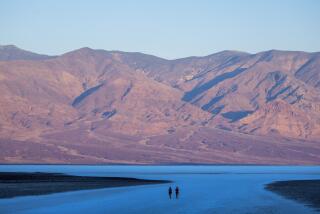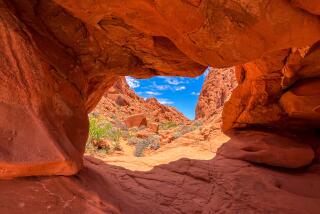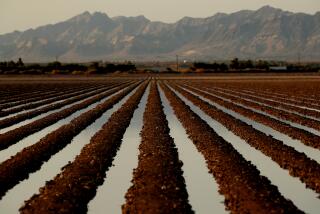Alive and well in the Arkansas Valley
- Share via
Salida, Colo. — I cast the fly rod, my right arm snapping back and then forward. The line curled through the air, and the imitation fly landed behind a rock 20 feet upstream. It swirled in the clear water for a few seconds, then gently drifted down the river.
The fly, a caddis -- meant to resemble the larva of the moth-like caddis fly -- bobbed and dipped as the current pulled it. It drifted past me, and I started to lift my rod to make another cast.
Wham! The line jerked, and the rod came to life. I fumbled for a moment before I realized what had happened and triumphantly hollered, “Fish on!”
For about five minutes, the fish and I danced. I reeled in a bit and then let it run, trying to tire it out. Eventually I worked it in close and was able to get the feisty fella near the fishing guide, who scooped it up with a net.
It was a fat, 14-inch brown trout. I gawked like a schoolboy. I’ve caught hundreds of fish, and I never tire of that feeling. With a surgeon’s skill, the guide removed the tiny hook from the fish’s mouth; then we set it free. Rod in hand, I waded back into the current to do it again.
This scene was unimaginable not long ago. The Arkansas River was so polluted from mining runoff that few trout lived here, and those that did were weak and scrawny. As wildlife dwindled, so did tourism in this classic Colorado river valley.
Today, thanks to a $75-million cleanup, the fish and game are back, along with the vitality of this region 140 miles southwest of Denver. Tourists are beginning to notice and are discovering -- or rediscovering -- the area’s small towns and natural beauties.
I was among them that morning in late April. My wife, Jessica, and I had decided to leave Denver behind for a few days, so we piled a couple of suitcases into the Subaru and set off for a much-needed weekend of relaxation in the Rocky Mountains.
The Arkansas River is best known for kayaking and rafting. The thrilling rapids -- some rated up to a white-knuckle Class 5 -- attract more than 300,000 boaters a year to the Arkansas River Valley.
But it’s the miles and miles of hiking trails and the challenge of climbing the high peaks -- 14 of them taller than 14,000 feet -- that lure me back most often. The recent day of fly-fishing on the river also opened my eyes to the other recreational possibilities in this rugged and beautiful land.
A visit to the Arkansas Headwaters Recreation Area, a 120-mile stretch of river valley in central Colorado, offers a chance to experience the real Colorado, unspoiled by high-rise condominiums, $100-a-round golf courses, overpriced restaurants and busy interstate traffic.
That’s largely because about half of the land adjacent to the expansive river valley is protected wilderness. So while other parts of the state have turned into fashionable resort communities, with plenty of glitz and packaged, sanitized mountain experiences, the largely protected Arkansas River Valley quietly evolved into an offbeat and less expensive spot for those of us who crave the real deal.
Increasingly, mountain towns along the Arkansas River, such as Salida and Leadville, are shedding their backward images and dingy digs for contemporary restaurants, espresso bars, art galleries and quaint bed-and-breakfasts, all the while preserving the sense of history and adventurous spirit that make the region unique.
An inn with an infamous past
Jessica and I got a taste of the region’s history when we spent the night at the Nordic Inn, a 19th century stagecoach stop that evolved into a brothel, then a speakeasy and finally a bed-and-breakfast. In the town of Twin Lakes at the foot of Colorado’s highest peak, 14,433-foot Mt. Elbert, the inn is surrounded by jagged mountains.
It has a rustic feel, its 14 rooms filled with antiques and named for the infamous ladies of the night who once prowled its halls. My favorite was Cora’s Room, honoring a happy hooker who had no teeth.
After breakfast, Jessica and I drove to Buena Vista, where I met Pat Chant, lead guide for Colorado Fly Fishing Guides. Jessica, who is working on her MBA, dropped me off and spent the day studying for a final. Chant and I hit the river.
A longtime Arkansas River Valley resident, Chant mixed stories of the valley’s history with casting tips as we worked a stretch of water above Salida. The most intriguing tale was that we were fishing the river at all.
“In 1991-92, people told me, ‘Oh, you’re fishing the dead river,’ ” he said at one point. “I was fishing alone for years.”
The river starts in the high mountains above Leadville, where melting snow spills down the steep slopes and forms the genesis of a mighty waterway that flows through Colorado, Kansas, Oklahoma and Arkansas before meeting the Mississippi River.
But the mountains surrounding Leadville are filled with hundreds of mines, dating to the gold and silver rushes of the late 1800s, that left thousands of tons of toxic waste. Snow runoff picked up the heavy metals and acidic compounds in the mine waste and carried it into the river.
Sometimes, during heavy runoff, the polluted river turned orange between Leadville and Buena Vista, about 35 miles downstream. Fish couldn’t survive.
A return to its natural state
In 1983 the Environmental Protection Agency declared a 16-square-mile area above Leadville a Superfund site, meaning the environmental threat was so great that cleaning it up was a national priority. Cleanup began in 1988 and is about 90% complete, said Mike Holmes, EPA project manager.
“Things gradually got better,” said Sam McGeorge, executive director of the National Mining Hall of Fame and Museum in Leadville. The museum, which has a comprehensive collection of mining memorabilia, is an interesting place to spend a few hours.
The booming fish population -- almost 5,000 brown and rainbow trout per square mile of river, according to the Colorado Department of Wildlife -- is the most obvious sign that things have improved. When pollution levels were at their highest, there were about 500 fish per square mile, and some stretches had no aquatic life at all.
The stretch of river between Pueblo and Salida is known for the Mother’s Day Caddis Hatch, when caddis flies fill the air around the river like a fog. The flies rest on the surface of the water, and brown trout gorge themselves on the bugs. Anglers relish the feeding frenzy and the extraordinary number of fish they can catch.
But fishing on the Arkansas is good year-round if you know where to look. If you don’t, hire a guide, which I found a worthwhile investment. (Rates start at $105 for a half-day of fishing and run up to $550 for a full day, including lunch, for six anglers.)
I didn’t see many kayakers or rafters in the areas where I fished, but that’s not surprising.
“The two sections don’t really overlap that much,” said Greg Felt, owner of Canyon Marine, an outfitter that runs whitewater rafting and fishing trips. “If you want the solitude of a fly-fishing experience in the morning, you can get that and then hit the whitewater in the afternoon.” There are more than 60 licensed rafting outfitters on the Arkansas, with half- and full-day trips available.
Arkansas Valley headquarters
After a pleasant day of fishing, I met Jessica in Salida at Bongo Billy’s, a trendy restaurant and bar with a sprawling deck that overlooks the river. I sipped a beer on the deck as she told me about her day, both of us occasionally glancing at kayakers playing in the river.
Salida is the cultural center of the Arkansas River Valley, with hip restaurants and funky art galleries mixing with bicycle and kayak stores to give the historic downtown an outdoorsy vibe.
We window-shopped before heading to the Gazebo Inn, a charming B&B; in a renovated Victorian within walking distance of downtown. We dumped our bags in our room and left for dinner, where we planned to celebrate Jessica’s 29th birthday.
Locals had suggested Grimo’s, an Italian restaurant in nearby Pancho Springs. It was a good choice, with entree prices ranging from $10.95 to $19.95.
We skipped dessert and headed back to the inn, capping the evening with a long soak in the outdoor hot tub, gazing up at the stars and shadowy peaks that surround Salida.
The next day, after a lazy morning, we made our way to the Gazebo Inn’s dining room, where we enjoyed a breakfast of Belgian waffles topped with bananas and homemade maple cream syrup.
After taking another stroll along the river in Salida, we turned the car north on Highway 24, which runs the length of the valley.
We were awed by the Collegiate Peaks, the string of 14,000-foot mountains that line the western edge of the Arkansas River Valley. Many are named for such Ivy League schools as Harvard and Yale.
The peaks and surrounding trails are among the area’s big draws. You can take a casual stroll through an alpine meadow or an epic trek to the top of a 14,000-foot mountain. You can spend a hour or a week.
One of my favorite climbs is 14,197-foot Mt. Princeton. It’s about a four-mile hike from the trail head to the top of this spectacular peak, gaining about 3,400 feet in elevation.
The hike is strenuous, but it takes no greater skill than putting one foot in front of the other. (Bring lots of water and start early to avoid getting caught in an afternoon thunderstorm, which is typical in the Rockies in the spring and summer.)
Because Princeton is essentially at the center of Colorado, those who make it to the rocky summit are rewarded with a fine panorama. The Arkansas River appears as a shimmering ribbon far below.
After the climb, I like to visit Mt. Princeton Hot Springs Resort at the base of the mountain. Nothing feels better than soaking in a natural hot spring when I need to restore my aching body.
On my next trip, I plan to explore the mountain biking near Salida and maybe learn to kayak. I’ve been visiting the area for years, and there is still much I want to do here.
The wonderful thing about the Arkansas River Valley is that it offers something for everyone. The options are as limitless as the view from atop Mt. Princeton.
*
(BEGIN TEXT OF INFOBOX)
Rocky Mountain paradise for hikers, anglers and kayakers
GETTING THERE:
From LAX to Denver, United, American and Frontier fly nonstop. Restricted fares begin at $268.
Car rentals are available at the airport.
From Denver, travel west on Interstate 70 for about 75 minutes. Exit at Highway 91 and head south, over Fremont Pass, to Leadville, the northernmost part of the Arkansas River Valley.
From Colorado Springs, take Interstate 25 south to Pueblo and catch Highway 50 west, which will take you to Canon City and the lower reaches of the Arkansas River.
WHERE TO STAY:
Twin Lakes Nordic Inn, 6435 Highway 82, Twin Lakes, CO 81251; (800) 626-7812, fax (719) 486-8902, www.twinlakesnordicinn.com. This bed-and-breakfast, built as a stagecoach stop in 1879, is in the San Isabel National Forest. It has been restored but retains a rustic charm. Double rooms from $68, including breakfast. Lunch and dinner available.
The Gazebo Country Inn, 507 E. 3rd St., Salida, CO 81201; (800) 565-7806, fax (719) 539-6971, www.gazebocountryinn.com. This bed-and-breakfast is within walking distance of restaurants, art galleries and shops. A fully restored Victorian home, the Gazebo has four rooms and a private cottage. Rates start at $70 and include breakfast.
Buena Vista KOA Kampground, 27700 County Road 303, Buena Vista, CO 81211; (800) 562-2672 or (719) 395-8318, fax (719) 395-3103, www.buenavista koa.com. This KOA offers sites for tents and RVs, with full electrical hookups. It also has a camp store, a recreation room, horseback rides, a playground and Internet access. Campsites start at $19.
WHERE TO EAT:
Tracks Coffee Co., 714 Harrison Ave., Leadville; (800) 801-5282, www.trackscoffee.com. This is a favorite breakfast spot for visitors and locals alike. Tracks bakes its own muffins, pastries and cinnamon rolls. It also roasts its own coffee beans. Breakfast items start at $2.75 for granola and fruit and rise to $6.49 for Southwestern scrambled eggs.
Amicas, 136 E. 2nd St., Salida; (719) 539-5219. A great little pizza joint and brewery, with a fun Art Deco interior. Entrees $6-$7.95.
Grimo’s Italian Restaurant, 146 Main St., Poncha Springs; (719) 539-2903. This traditional Italian place is about as nice as it gets in the Arkansas River Valley, but don’t expect a fine dining experience. The typical trattoria-style menu here would be considered about average in larger American cities. Entrees start at $10.95 and go up to $19.95, including homemade soup, salad and bread.
TO LEARN MORE:
Heart of the Rockies Chamber of Commerce, 406 W. Highway 50, Salida, CO 81201; (877) 772-5432 or (719) 539-2068, www.salidachamber.org.
Leadville/Lake County Chamber of Commerce, P.O. Box 861, Leadville, CO 80461; (800) 933-3901 or (719) 486-3900, www.leadvilleusa.com.
-- Kyle Henley
More to Read
Sign up for The Wild
We’ll help you find the best places to hike, bike and run, as well as the perfect silent spots for meditation and yoga.
You may occasionally receive promotional content from the Los Angeles Times.






